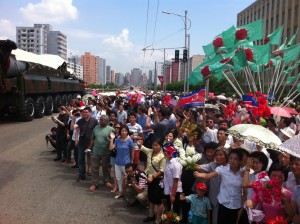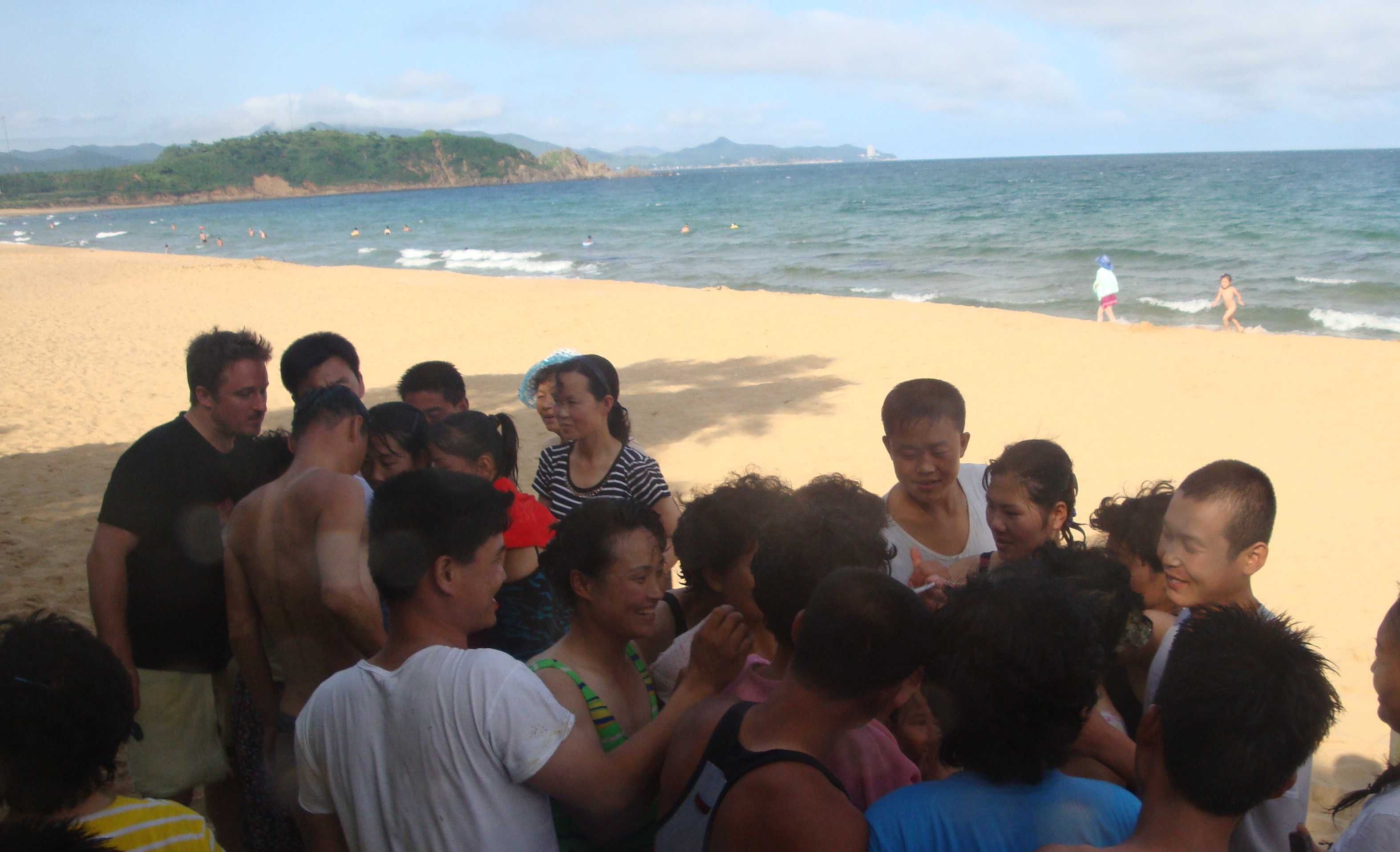Over the past few years, the tablet computer phenomenon has exploded. Over thirty percent of Americans are now proud owners of tablets, such as Apple’s iPad. The release of the iPad in 2010 sparked a tablet computer renaissance, reinventing the conception of mobile computing. Since then, companies like Microsoft and Google have thrown their hats into the mix. Recently, however, the device making waves in tech-circles does not hail from Silicon Valley or China, but rather one of the most isolated countries on the planet: North Korea. The Korean Computing Centre (KCC) first released a version of the Samjiyon tablet in Fall of 2012 at a trade show in Pyongyang. A new version, the Samjiyon SA-70, became available to North Korean consumers during Spring 2013.
This July, I was fortunate enough to spend a few weeks in the isolated country, where I was able to interact with the Samjiyon firsthand. It was just one of the many surprises I experienced in the DPRK that gave me pause, realizing that there is more to the isolated regime than is presented in Western media. The Samjiyon SA-70 operates on a plagiarized version of Google’s Android operating system, tweaked to conform to strict North Korean censorship policies. A professor of East Asian Studies at the University of Vienna and frequent visitor to the DPRK, Ruediger Frank, published an in-depth sixteen page review of the tablet in late October, generating a media frenzy in publications like the Washington Post and Wall Street Journal. His review concludes that overall the Samjiyon is an impressive product: “the North Korean Samjiyon SA-70 tablet is in many ways a remarkable device that has so far not received its due share of attention.” While the DPRK is a developing country with many deficiencies and problems to be addressed, but the release of a piece of technology such as this, theoretically available to the average person, is a major milestone in North Korea’s technological development.
The Samjiyon SA-70 is an impressive device, coming pre-loaded with fourteen games, a fully functional Microsoft Office suite, a multi-language dictionary, over 100 e-books, English and Chinese language lessons, and a multi-volume encyclopedia. The software itself is impressive in its functionality, but even more impressive and implicative is the hefty amount of pre-loaded resources. The North Korean government exerts strict ideological control over its society, which means that the content on its state-sponsored tablet is officially endorsed to its citizens. However, at the same time as the foreign ministry espouses rhetoric critical of Western institutions and culture, novels such as Gone with the Wind, Les Miserables, Ivanhoe, and more than two-dozen other Western novels were included on the Samjiyon, all centered on the theme of critiquing Western society.
The tablet encyclopedia itself includes over 83,000 entries. While the introduction asserts the main focus of the encyclopedia is the “the immortal achievements of leaders Kim Il-sung and Kim Jong-il and the revolutionary leadership of the Korean Worker’s Party,” the Immortal History and Immortal Leadership sections are mostly historical in nature, discussed in a way similar to Americans’ conversations about our revered Founding Fathers. Rarely is history objective in nature. When I was able to use a Samjiyon tablet while in the DPRK, I was encouraged by the accurate information covering a wide array of topics available in the encyclopedia – the scientific information in the encyclopedia was quite extensive and accurate by standards of my limited scientific expertise.
Due to the forcibly private nature of the country, little information from the DPRK spreads to the outside world. This encyclopedia is a vast treasure trove of North Korean cultural, literary, scientific, and political information. These resources are also invaluable to academics attempting to understand the inner workings and self-identity of the DPRK. Accepting that cultural and political information disseminated by the government is biased, much insight can still be gained through access to new information, especially sources meant for a domestic audience rather than the official party line offered by the foreign ministry. The informational materials included on the Samjiyon will prove a most valuable asset for foreign researchers.
In fact, the Samjiyon SA-70 is comparable to the iPad Air in terms of hardware. It also features an extendable antenna that allows analog TV to be viewed. During the July 27 Victory Day celebrations in Pyongyang, I watched official state coverage of the pomp and circumstance in Kim Il-sung Square along with a group of locals on the steps of an apartment complex. I thought that my new friends would be intrigued by this device that played TV without any cords, a feat that even some Westerners would even be surprised by, but they were all more interested in what the television channel was showing. The DPRK may be a developing country, but it is not as isolated as many in the West assume. Even as I traveled into the countryside and cities less connected to the outside world, I found that average are somewhat aware of current events, South Korean pop culture, and modern technology.
DPRK state-sponsored media outlets claim that the Samjiyon was a product of the North Korean people, developed and produced completely in country. This is most certainly not the case. The fledgling North Korean tech industry has proven competent in developing software, but several reports have claimed that Hong Kong based tech company Shenzhen Yecon Industry Co built the tablet hardware. More important than the false claims of entirely domestic production by the government is what the existence of this tablet symbolizes for the DPRK. The cooperation necessary to produce a high-quality product like the Samjiyon is complex to say the least. Trans-national trade is traditionally not a strength of North Korea, an obvious repercussion of isolationist policies. Collaboration with the outside world to create this tablet is encouraging. Furthermore, it seems as though China is betting on an expanded market in the DPRK. In Dandong, a city on the Chinese side of the Yalu river, an influx of Chinese investment has spawned development. The city has the energy of a frontier town, buzzing with optimism of new opportunities. “Dandong accounts for 70 per cent of North Korea’s trade with China and the outside world, and in anticipation of better times ahead, when North Korea may slowly transform itself into an economic miracle like China, China is already preparing the path for North Korea to follow,” noted a recent article in the New Strait Times. A new bridge connecting the two countries is currently under construction and is scheduled to be completed in 2014. With the mobilization of Chinese investment along the Yalu River and cooperation to create the Samjiyon, economic trends seem to point upwards, eliciting optimism for a North Korea more connected to the world.
The response to the release of the Samjiyon tablet in Western circles is fairly representative of the general perception of North Korea as a whole. That is, the country is feeble and incapable, led by an irrational, crazy leader who is worshipped by the brainwashed masses. In actuality, this is a tragic misperception bred by a lack of cultural understanding. A blogger for the liberal magazine Slate detailed the resources included on the Samjiyon tablet, saying it “does come pre-loaded with some totalitarian goodies designed to teach children how to form a neat line, draw the extremely complex North Korean flag, and generally be good citizens (read: minions).” It is no surprise that the average American citizen views the DPRK as a cartoonish state when reputable media outlets feed them information presented this way. In addition, American society has contributed to the cartoonish persona through movies like Team America World Police and caricatured articles.

Unfortunately, misconceptions about the DPRK drive American policymaking. American Exceptionalism blinds most Americans to the source of North Korean skepticism and resentment of the West. The Korean War is often referred to as the “Forgotten War” in US history, but to Koreans, especially North Koreans, its legacy is painfully ingrained into their culture. The UN forces, spearheaded by the United States military, were responsible for a massive bombing campaign that dropped over 635,000 tons of bombs on the DPRK, leveling 80 percent of all standing structures north of the 38th parallel. To North Koreans, American imperialism is as much of a reality as Japanese imperialism in the early 20th century, which culminated in a thirty-year occupation. If US policymakers would attempt to empathize with North Koreans, the rhetoric coming out of the DPRK wouldn’t seem so irrational.
The existence of the Samjiyon tablet does not change the daily lives of most North Koreans, but it is a mark of progress for the country. Technologically speaking, state companies are able to manufacture a product comparable to the best available in the West, and while censorship is still a reality of daily life, governmental efforts to increase access to education are encouraging. In practice, the Samjiyon will primarily be available to upper-class consumers, but its effects are farther-reaching than a luxury for the privileged. This tablet will provide the outside world with a source of study of the Hermit Kingdom, hopefully bringing about a deeper understanding of how to interact with the country and its people.
Although human rights violations are a reality in North Korea, as is immense poverty, America has no right to speak down to other nations as the moral voice of the world, though. Human Rights Watch, among others, condemns the United States for indiscriminate killings of civilians around the world and domestic prison policies that violate international law. American Exceptionalism creates a set of blinders, shielding the US from its own downfalls and magnifying those of others. The DPRK is not an evil entity hell-bent on bringing down the West as the United States government and media insist. The Samjiyon could be a sign of increasing freedom and a hopeful future for the DPRK and its people. Who knows – maybe a descendant of the Samjiyon will be the next big thing American consumers will be frantically rushing to purchase the day of its release.
